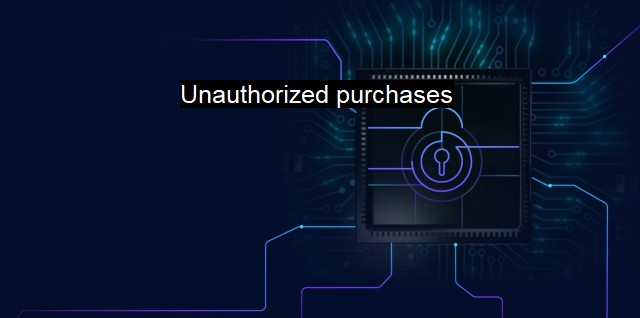What are Unauthorized purchases?
Unauthorized Purchases: Risks and Precautions in the Cybersecurity and Antivirus Context
Unauthorized purchases refer to fraudulent activities involving the use of another individual's financial information to make transactions without their knowledge and consent. It’s a pervasive issue largely influenced by increased participation in online shopping and a heavy reliance on digital payment systems. Tasks that were once physically transacted are now fulfilled virtually, increasing the risk of unauthorized purchases.In the context of unauthorized purchases, cybersecurity involves preventing digital crimes by guarding an individual's, an organization's, or a system's digital information. The rampant instance of unauthorized purchases has catalyzed a pressing need for effective cybersecurity measures, including antivirus software, to ensure user data is safeguarded from malicious hackers with fraudulent intentions.
One highlight of unauthorized purchases is a practice called ‘phishing.' It is an activity where unauthorized individuals, commonly fraudsters and hackers, trick unsuspectING users into revealing their sensitive information such as login credentials and credit card details. Primarily carried forth through hoax emails, misleading websites, texts, or phone calls, these malicious tricks have a primary objective of conducting illicit transactions or purchases unauthorized by the account owner.
The significant impacts of unauthorized purchases go beyond financial loss. It poses extreme threats to victims as they may face severe consequences, including identity theft, personal reputation damage, credit score decline, and emotional distress. Therefore, cybersecurity measures are not merely digital security precautions but provide emotional and psychological safeguards for users.
With such devastating real-world implications, it's essential to scrutinize potential cybersecurity measures to prevent unauthorized purchases. Antivirus software is one such surefire tool for restraining unauthorized individuals from gaining access to our financial data. It tirelessly monitors for threats, runs routine checks, and speedily captures and eliminates viruses from one's system, keeping your digital environment free from infectious malware.
Advanced cybersecurity systems are equipped with antivirus tools that possess real-time malware recognition. This feature ensures that threats are not only recognized at an accelerating quick rate but are also blocked and removed instantly, thus, significantly reducing the window for hackers to operate.
Similarly, they also boast heuristic analysis functions. This critical function allows antivirus software to distinguish patterns within a file or a system that triggers fraudulent actions, such as unauthorized purchases. As this technology captures the slightest signs of cyberthreats, it drastically accentuates security precautions, verifying that one's financial data is profoundly safe and shielded.
Firewalls in cybersecurity systems also play an essential part in preventing unauthorized purchases. They regulate incoming and outgoing network traffic and thwart hazardous cyber traffic, providing an added layer of security.
a modern antivirus system implements advanced Artificial Intelligence (AI) techniques for increased surveillance on data traffic to provide better data protection against impending cyber threats. With learning algorithms, AI can predict suspicious patterns and mitigate unauthorized purchases risk even before they occur.
It is crucial to remember the role of personal vigilance in confronting unauthorized purchases—a superior cybersecurity tool in oneself. Being wary about sharing sensitive information, employing strong and unique passwords, regularly updating software, and scrutinizing the authenticity of emails and websites can significantly diminish the chances of falling prey to unauthorized purchasing activities.
Unauthorized purchases are a substantial cybersecurity threat that necessitates effective stop-gap measures. Antivirus solutions imbued with advanced cybersecurity features offer staunch protection against these malicious attacks, warding off potential unauthorized purchases, and ensuring safe online transactions. personal mindfulness of possible threats serves as the best defense, emphasizing the notion that cybersecurity starts with you.

Unauthorized purchases FAQs
What are unauthorized purchases in the context of cybersecurity and antivirus?
Unauthorized purchases in the context of cybersecurity and antivirus refer to transactions that are made without the knowledge or consent of the account owner. These transactions are typically made using stolen payment information or through phishing scams.How can I protect myself from unauthorized purchases?
To protect yourself from unauthorized purchases, it is important to keep your antivirus software up to date and to be cautious when entering personal and financial information online. You should also regularly monitor your bank and credit card statements for any suspicious activity.What should I do if I notice unauthorized purchases on my account?
If you notice unauthorized purchases on your account, you should immediately contact your bank or credit card company and report the fraud. They can help you block any further unauthorized transactions and recover any funds that were stolen. You should also file a report with the appropriate authorities, such as the Federal Trade Commission or local police department.Can antivirus software prevent unauthorized purchases?
Antivirus software can help prevent unauthorized purchases by blocking access to malicious websites and detecting and removing malware that could steal your personal and financial information. However, it is not foolproof, and you should still practice safe browsing habits and monitor your accounts regularly for any suspicious activity.| | A | | | B | | | C | | | D | | | E | | | F | | | G | | | H | | | I | | | J | | | K | | | L | | | M | |
| | N | | | O | | | P | | | Q | | | R | | | S | | | T | | | U | | | V | | | W | | | X | | | Y | | | Z | |
| | 1 | | | 2 | | | 3 | | | 4 | | | 7 | | | 8 | | |||||||